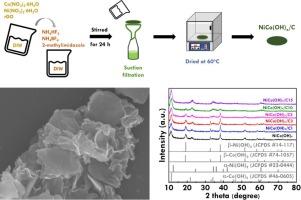通过在超级电容器中加入新型结构引导剂,提高镍和钴氢氧化物与还原氧化石墨烯的储能能力
IF 8.9
2区 工程技术
Q1 ENERGY & FUELS
引用次数: 0
摘要
沸石咪唑酸盐框架 67 (ZIF67) 衍生物被认为是一种潜在的储能活性材料,因为它可以增强导电性并保持高表面积和可调孔隙结构。然而,目前对 ZIF67 衍生物电学和物理性质的改进仍不足以实现卓越的储能能力。本研究在 ZIF67 衍生物的合成过程中加入了新型碳材料和结构引导剂 (SDA),以增强导电性并调节形态。研究分别采用了商用还原氧化石墨烯(rGO)、NH4BF4 和 NH4HF2 作为碳材料和 SDA。在最佳的 rGO 比例下,rGO/ZIF67 衍生物电极在 20 mV/s 时显示出更高的比电容(CF),达到 1304.7 F/g(913.0 C/g),而不含 rGO 的 ZIF67 衍生物电极的比电容值为 786.9 F/g(550.8 C/g)。由最佳 rGO/ZIF67 衍生物和 rGO 电极组成的超级电容器在 350 W/kg 的条件下,最大能量密度为 30.2 Wh/kg。经过 10,000 次循环后,该装置的库仑效率达到 93.0%,CF 保持率达到 86.5%。新型碳材料和 SDA 可望应用于更多的电化学系统,以获得更好的储能能力。本文章由计算机程序翻译,如有差异,请以英文原文为准。

Improving energy storage ability of nickel and cobalt hydroxides coupled with reduced graphene oxide via incorporating novel structure-directing agents for supercapacitors
Zeolitic imidazolate framework 67 (ZIF67) derivatives are regarded as potential active materials for energy storage, owing to the possible enhancement on electrical conductivity and maintenance of high surface area and tunable pore structure. However, current improvements on electrical and physical properties of ZIF67 derivatives are still insufficient to achieve excellent energy storage abilities. In this study, new types of carbon material and structure-directing agents (SDA) are incorporated into the synthesis of ZIF67 derivatives to enhance electrical conductivity and modulate morphology. Commercial reduced graphene oxide (rGO), NH4BF4 and NH4HF2 are applied as the carbon material and SDAs, respectively. With the optimal rGO ratio, the rGO/ZIF67 derivative electrode exhibits a higher specific capacitance (CF) of 1304.7 F/g (913.0 C/g) at 20 mV/s, while the ZIF67 derivative electrode without rGO shows a CF value of 786.9 F/g (550.8 C/g). The supercapacitor composed of the optimal rGO/ZIF67 derivative and rGO electrodes presents a maximum energy density of 30.2 Wh/kg at 350 W/kg. The Coulombic efficiency of 93.0% and CF retention of 86.5% are achieved for the device after 10,000 cycles. The novel carbon material and SDAs are expected to be applicable in more electrochemical systems to achieve better energy storage ability.
求助全文
通过发布文献求助,成功后即可免费获取论文全文。
去求助
来源期刊

Journal of energy storage
Energy-Renewable Energy, Sustainability and the Environment
CiteScore
11.80
自引率
24.50%
发文量
2262
审稿时长
69 days
期刊介绍:
Journal of energy storage focusses on all aspects of energy storage, in particular systems integration, electric grid integration, modelling and analysis, novel energy storage technologies, sizing and management strategies, business models for operation of storage systems and energy storage developments worldwide.
 求助内容:
求助内容: 应助结果提醒方式:
应助结果提醒方式:


